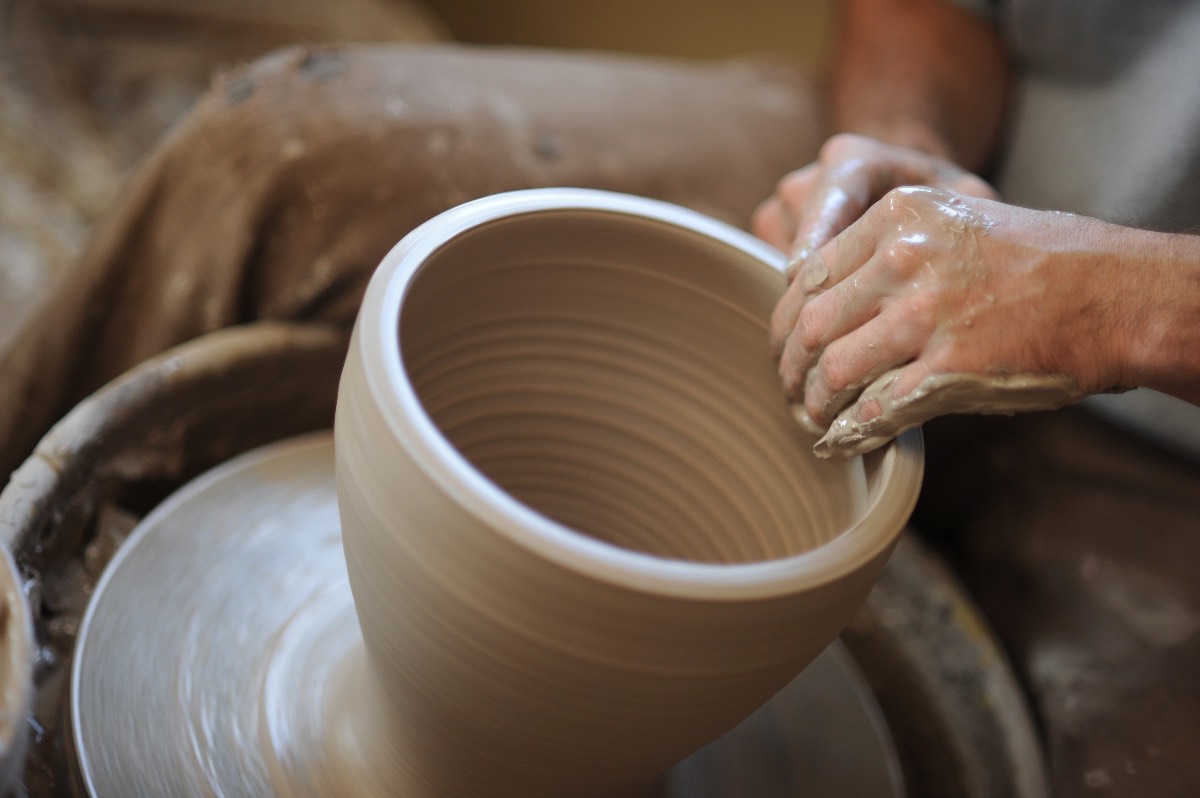Ceramics Safety
Ceramics art has a wide variety of hazards. The specific hazards and precautions may include working with clay, glazing and coloring, firing in a kiln, and potential leaching of finished ware.

Clay Hazards
Clays are minerals composed of hydrated aluminum silicates often containing large
amounts of free crystalline silica. The primary health hazard is from repeated breathing
of clay dusts which can cause permanent scaring to lung tissue. Excessive dusts occur
when dry clay is mixed without ventilation or allowed to accumulate on surfaces.
Safety guidelines to minimize exposure to clay dusts:
-
Use premixed clay if possible to avoid exposure to large quantities of clay dust.
- Clay storage and mixing should take place in a separate, well-ventilated room.
- Always use the ventilation system during mixing to remove fine silica dust particles from the air.
- Clay mixers should be equipped with proper machine guards so that they cannot be opened to add clay or water while the mixer blades are turning.
- Always be alert to the potential for your hands or clothing to get caught in the plug mill, never put your hand in the hopper!
- Make sure the studio is cleaned daily by wet-mopping and washing methods.
- Dry sweeping and vacuuming must be avoided unless a HEPA filter vacuum is used.
- Wash hands thoroughly after working.
Alleviate back strain and wrist injuries by practicing good work habits:
- Adjust wheel height to enable work with your back straight.
- Avoid heavy lifting
- Avoid repetitive motions by varying your daily routine.
Glaze Hazards
Glaze contains a mixture of silica, fluxes and colorants. Fluxes and colorants can
be highly toxic by inhalation. Highly toxic glaze constituents include: Antimony,
Arsenic, Barium, Beryllium, Cadmium, Chromium, Cobalt, Lead, Lithium, Manganese, Nickel,
Uranium, or Vanadium.
Safety guidelines to minimize exposure to toxic glaze:
- Use lead-free glazes. If the glaze does not state “lead-free” or “leadless” on the label, assume it contains lead until proven otherwise.
- Avoid using colorants that are known or probable human carcinogens (arsenic, beryllium, cadmium, chromium Vanadium, nickel, and uranium). There is no known safe level for carcinogens!
- Know what you are working with. Read the safety data sheet and understand the hazards.
- Mix and weigh glazes in an exhaust hood. Wet glazes are not an inhalation hazard. Use a wet mop to clean spilled powders.
- Wear gloves when handling wet or dry glazes.
- Perform all glaze spraying in a ventilated booth.
- Wash hands thoroughly after each use.
Kiln Hazards
- Electric kilns and fuel-fired kilns are used to heat the pottery to the desired firing temperature. Fuel-fired kilns are heated by burning gas (natural or propane), oil, wood, coke, charcoal or other materials. The fuels produce carbon monoxide and other combustion gases. Fuel-fired kilns are usually vented from the top through a chimney. Firing temperatures can vary from as low as 1382°F for raku and bisque wares, to as high as 2372 °F for stoneware, and 2642 °F for certain porcelains.
- The early stage of bisque firing involves the oxidization of organic clay matter to carbon monoxide and other combustion gases. Sulfur breaks down later producing highly irritating sulfur oxides. Also, nitrates and nitrogen-containing organic matter break down to nitrogen oxides.
- Galena, cornish stone, crude feldspars, low grade fire clays, fluorspar, gypsum, lepidolite and cryolite can release toxic gases and fumes during glaze firings. Carbonates, chlorides, and fluorides are broken down to releasing carbon dioxide, chlorine, and fluorine gases.
- At or above stoneware firing temperature, lead, antimony, cadmium, selenium and precious metals vaporize and the metal fumes can either escape from the kiln, or settle inside the kiln or on ceramic ware in the kiln. Nitrogen oxides and ozone can be generated from oxygen and nitrogen in air.
- Only personnel who have been instructed in firing procedures may operate the kilns. A complete understanding of firing procedures and safety components is essential to avoid personal injuries or damage to the kiln.
Processes such as Raku Firing and Salt Glazing present unique safety hazards and should only be done outdoors away from air intakes or open windows of buildings. Close faculty or graduate assistant supervision is required at all times.
Salt glazing involves throwing wet salt into the heated kiln while the bisque ware is being fired. If sodium chloride salt is added, hydrogen chloride gas is formed which is highly toxic by inhalation. Hydrogen chloride and water vapor also form corrosive hydrochloric acid which can corrode metal fittings in the area. Sodium carbonate should be substituted for sodium chloride as carbon dioxide gas is generated instead of hydrogen chloride.
Raku firing involves firing ware at a low temperature in a regular gas kiln and then removing the hot pieces and placing them in sawdust, leaves, or other organic materials for the reduction phase. The reduction phase releases large amounts of smoke and carbon monoxide and treated materials can also produce highly toxic compounds.
In the event of a kiln-room malfunction (smoke, odor, flame outside kiln, or water leaks on electric kilns) immediately notify Ceramics staff. In an emergency, evacuate the studio and contact campus emergency services (828-227-8911).
Machine Guarding
All mechanical equipment is to be equipped with guards that prevent access to electrical connections or moving parts, such as belts and pulleys of a vacuum pump. Each worker should inspect equipment before using it to ensure that the guards are in place and functioning. Careful design of guards is vital. An ineffective guard can be worse than none at all, because it may give a false sense of security. Emergency shutoff devices may be needed in addition to electrical and mechanical guarding. Please reference the Machine Guarding Program for more information.